Pitch Channel Control of a REMUS AUV with Input Saturation and Coupling Disturbances
Abstract
:1. Introduction
2. Model
2.1. Underwater Vehicle Model
2.2. Pitch Channel Model for REMUS AUV via Taylor Formula Simplification
3. Control Strategy
3.1. L1 Adaptive Control
3.2. Augment Adaptive Control with Riccati-Based Anti-Windup Compensator
4. Results and Discussion
4.1. Model Characteristics
4.2. Conditions and Parameters
4.3. Control Experiments Comparison
5. Conclusions
Acknowledgments
Author Contributions
Conflicts of Interest
References
- Fossen, T.I. Guidance and Control of Ocean Vehicles; John Wiley & Sons Inc.: Chichester, UK, 1994. [Google Scholar]
- Cui, R.; Zhang, X.; Cui, D. Adaptive sliding-mode attitude control for autonomous underwater vehicles with input nonlinearities. Ocean Eng. 2016, 123, 45–54. [Google Scholar] [CrossRef]
- Li, H.; Jing, X.; Karimi, H.R. Output-feedback-based H∞ control for vehicle suspension systems with control delay. IEEE Trans. Ind. Electron. 2014, 61, 436–446. [Google Scholar] [CrossRef]
- Sarhadi, P.; Noei, A.R.; Khosravi, A. Model reference adaptive pid control with anti-windup compensator for an autonomous underwater vehicle. Robot. Auton. Syst. 2016, 83, 87–93. [Google Scholar] [CrossRef]
- Hassanein, O.; Anavatti, S.G.; Shim, H.; Ray, T. Model-based adaptive control system for autonomous underwater vehicles. Ocean Eng. 2016, 127, 58–69. [Google Scholar] [CrossRef]
- Lavretsky, E.; Gadient, R.; Gregory, I.M. Predictor-based model reference adaptive control. J. Guid. Control Dyn. 2010, 33, 1195–1201. [Google Scholar] [CrossRef]
- Lavretsky, E.; Wise, K. Robust and Adaptive Control with Aerospace Applications; Springer: London, UK, 2013. [Google Scholar]
- He, W.; Dong, Y.; Sun, C. Adaptive neural impedance control of a robotic manipulator with input saturation. IEEE Trans. Syst. Man Cybern. Syst. 2016, 46, 334–344. [Google Scholar] [CrossRef]
- He, W.; Chen, Y.; Yin, Z. Adaptive neural network control of an uncertain robot with full-state constraints. IEEE Trans. Cybern. 2016, 46, 620–629. [Google Scholar] [CrossRef] [PubMed]
- Xiao, B.; Yin, S.; Kaynak, O. Tracking control of robotic manipulators with uncertain kinematics and dynamics. IEEE Trans. Ind. Electron. 2016, 63, 6439–6449. [Google Scholar] [CrossRef]
- He, W.; Kong, L.; Dong, Y.; Yu, Y.; Yang, C.; Sun, C. Fuzzy tracking control for a class of uncertain mimo nonlinear systems with state constraints. IEEE Trans. Syst. Man Cybern. Syst. 2017, 1–12. [Google Scholar] [CrossRef]
- Nicholas, L.T.; Valladarez, D.; Du Toit, N.E. Robust adaptive control of underwater vehicles for precision operations. In Proceedings of the OCEANS’15 MTS/IEEE, Washington, DC, USA, 19–22 October 2015; pp. 1–7. [Google Scholar]
- Wang, H.; Chen, B.; Liu, X.; Liu, K.; Lin, C. Robust adaptive fuzzy tracking control for pure-feedback stochastic nonlinear systems with input constraints. IEEE Trans. Cybern. 2013, 43, 2093–2104. [Google Scholar] [CrossRef] [PubMed]
- Wang, H.; Liu, X.; Liu, K. Adaptive neural data-based compensation control of non-linear systems with dynamic uncertainties and input saturation. IET Control Theory Appl. 2015, 9, 1058–1065. [Google Scholar] [CrossRef]
- Sarhadi, P.; Noei, A.R.; Khosravi, A. Adaptive integral feedback controller for pitch and yaw channels of an auv with actuator saturations. ISA Trans. 2016, 65, 284–295. [Google Scholar] [CrossRef] [PubMed]
- Hovakimyan, N.; Cao, C. L1 Adaptive Control Theory: Guaranteed Robustness with Fast Adaptation; SIAM: Philadelphia, PA, USA, 2010. [Google Scholar]
- Wang, X.; Hovakimyan, N. L1 adaptive controller for nonlinear reference systems. In Proceedings of the American Control Conference (ACC), San Francisco, CA, USA, 29 June–1 July 2011; pp. 594–599. [Google Scholar]
- Kharisov, E.; Hovakimyan, N.; Åström, K.J. Comparison of architectures and robustness of model reference adaptive controllers and L1 adaptive controllers. Int. J. Adapt. Control Signal Process. 2014, 28, 633–663. [Google Scholar] [CrossRef]
- Maalouf, D.; Chemori, A.; Creuze, V. Stability analysis of a new extended L1 controller with experimental validation on an underwater vehicle. In Proceedings of the 2013 IEEE 52nd Annual Conference on Decision and Control (CDC), Florence, Italy, 10–13 December 2013; pp. 6149–6155. [Google Scholar]
- Maalouf, D.; Chemori, A.; Creuze, V. L1 adaptive depth and pitch control of an underwater vehicle with real-time experiments. Ocean Eng. 2015, 98, 66–77. [Google Scholar] [CrossRef]
- Maalouf, D.; Creuze, V.; Chemori, A. A novel application of multivariable L1 adaptive control: From design to real-time implementation on an underwater vehicle. In Proceedings of the 2012 IEEE/RSJ International Conference on Intelligent Robots and Systems(IROS), Vilamoura-Algarve, Portugal, 7–11 October 2012; pp. 76–81. [Google Scholar]
- Sofrony, J.; Turner, M.C.; Postlethwaite, I. Anti-windup synthesis using riccati equations. Int. J. Control 2007, 80, 112–128. [Google Scholar] [CrossRef]
- Yin, S.; Gao, H.; Qiu, J.; Kaynak, O. Adaptive Fault-Tolerant Control for Nonlinear System With Unknown Control Directions Based on Fuzzy Approximation. IEEE Trans. Syst. Man. Cybern. Syst. 2017, 47, 1909–1918. [Google Scholar] [CrossRef]
- Yin, S.; Gao, H.; Qiu, J.; Kaynak, O. Fault detection for nonlinear process with deterministic disturbances: A just-in-time learning based data driven method. IEEE Trans. Cybern. 2017, 47, 3649–3657. [Google Scholar] [CrossRef] [PubMed]
- Oliveira, M.Z.; da Silva, J.M.G.; Coutinho, D.; Tarbouriech, S. Design of anti-windup compensators for a class of nonlinear control systems with actuator saturation. J. Control Autom. Electr. Syst. 2013, 24, 212–222. [Google Scholar] [CrossRef]
- Sarhadi, P.; Ranjbar Noei, A.; Khosravi, A. L1 adaptive pitch control of an autonomous underwater vehicle. Int. J. Intell. Unmanned Syst. 2014, 2, 107–120. [Google Scholar] [CrossRef]
- Valladarez, ND. An Adaptive Approach for Precise Underwater Vehicle Control in Combined Robot-Diver Operations. Master Thesis, Naval Postgraduate Naval Postgraduate School, Monterey, CA, USA, 2015. [Google Scholar]
- Prestero, T. Development of a six-degree of freedom simulation model for the REMUS autonomous underwater vehicle. In Proceedings of the OCEANS, MTS/IEEE Conference and Exhibition, Honolulu, HI, USA, 5–8 November 2001; Volume 1, pp. 450–455. [Google Scholar]
- Sarhadi, P.; Yousefpour, S. State of the art: Hardware in the loop modeling and simulation with its applications in design, development and implementation of system and control software. Int. J. Dyn. Control 2015, 3, 470–479. [Google Scholar] [CrossRef]
- Prestero, T. Verification of a Six-Degree of Freedom Simulation Model for the Remus Autonomous Underwater Vehicle. Master Thesis, Massachusetts Institute of Technology, Cambridge, MA, USA, 2001. [Google Scholar]
- Wu, N.L.; Wang, X.Y.; Ge, T.; Wu, C.; Yang, R. Parametric identification and structure searching for underwater vehicle model using symbolic regression. J. Mar. Sci. Technol. 2016, 1, 51–60. [Google Scholar] [CrossRef]
- Yang, R.; Clement, B.; Mansour, A.; Li, M.; Wu, N. Modeling of a complex-shaped underwater vehicle for robust control scheme. J. Intell. Robot. Syst. 2015, 80, 491–506. [Google Scholar] [CrossRef]
- Yang, S.-K. Observer-based anti-windup compensator design for saturated control systems using an LMI approach. Comput. Math. Appl. 2012, 64, 747–758. [Google Scholar] [CrossRef]
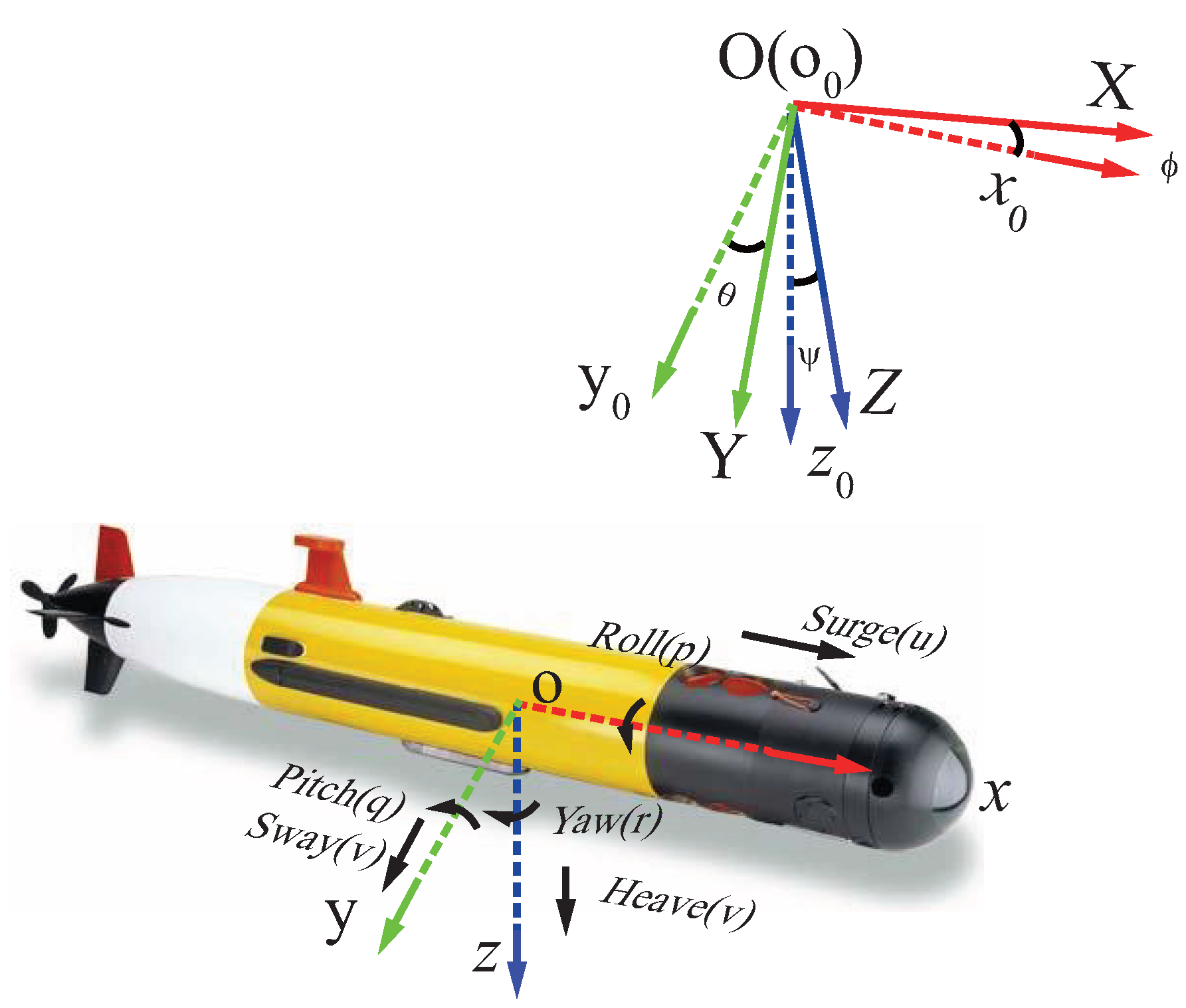
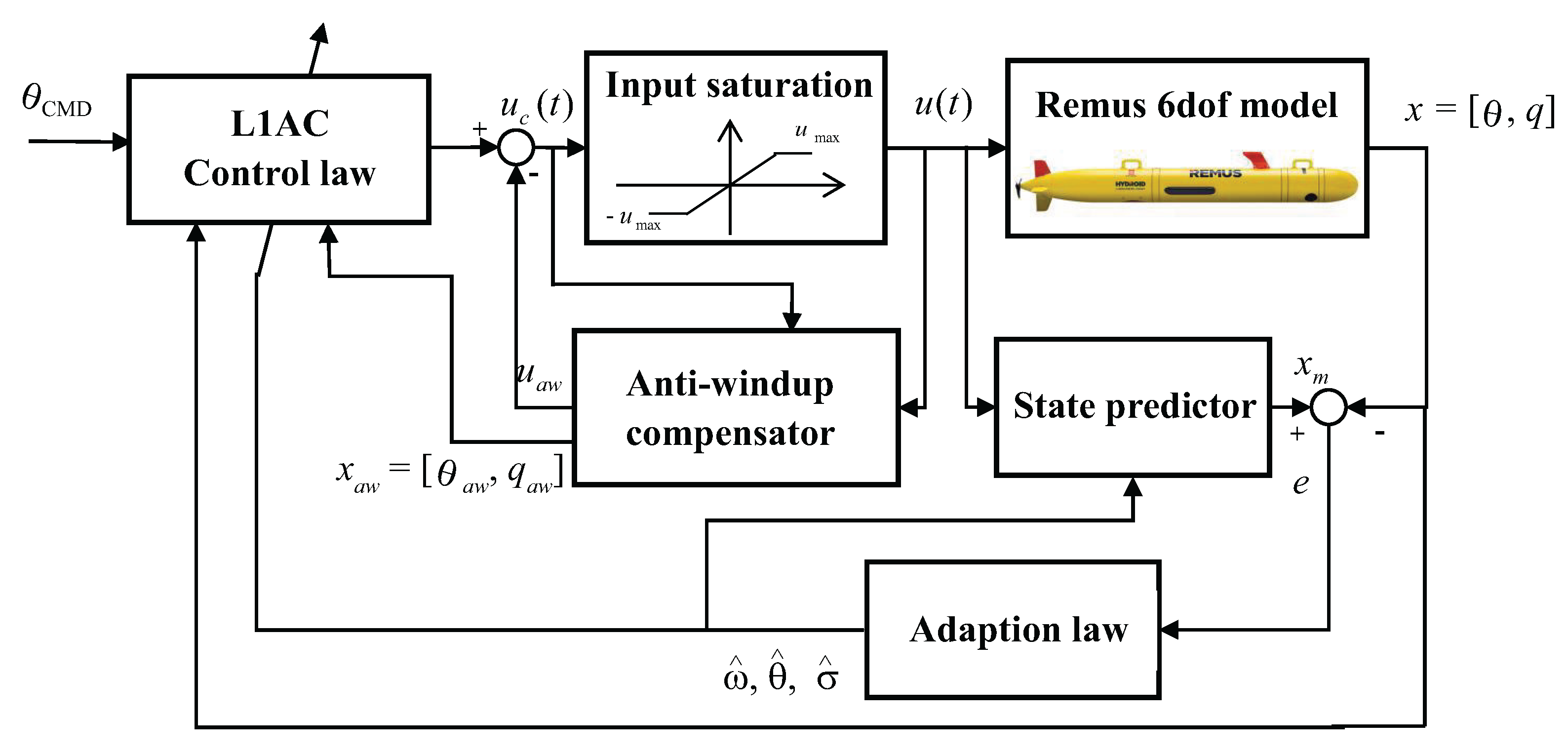

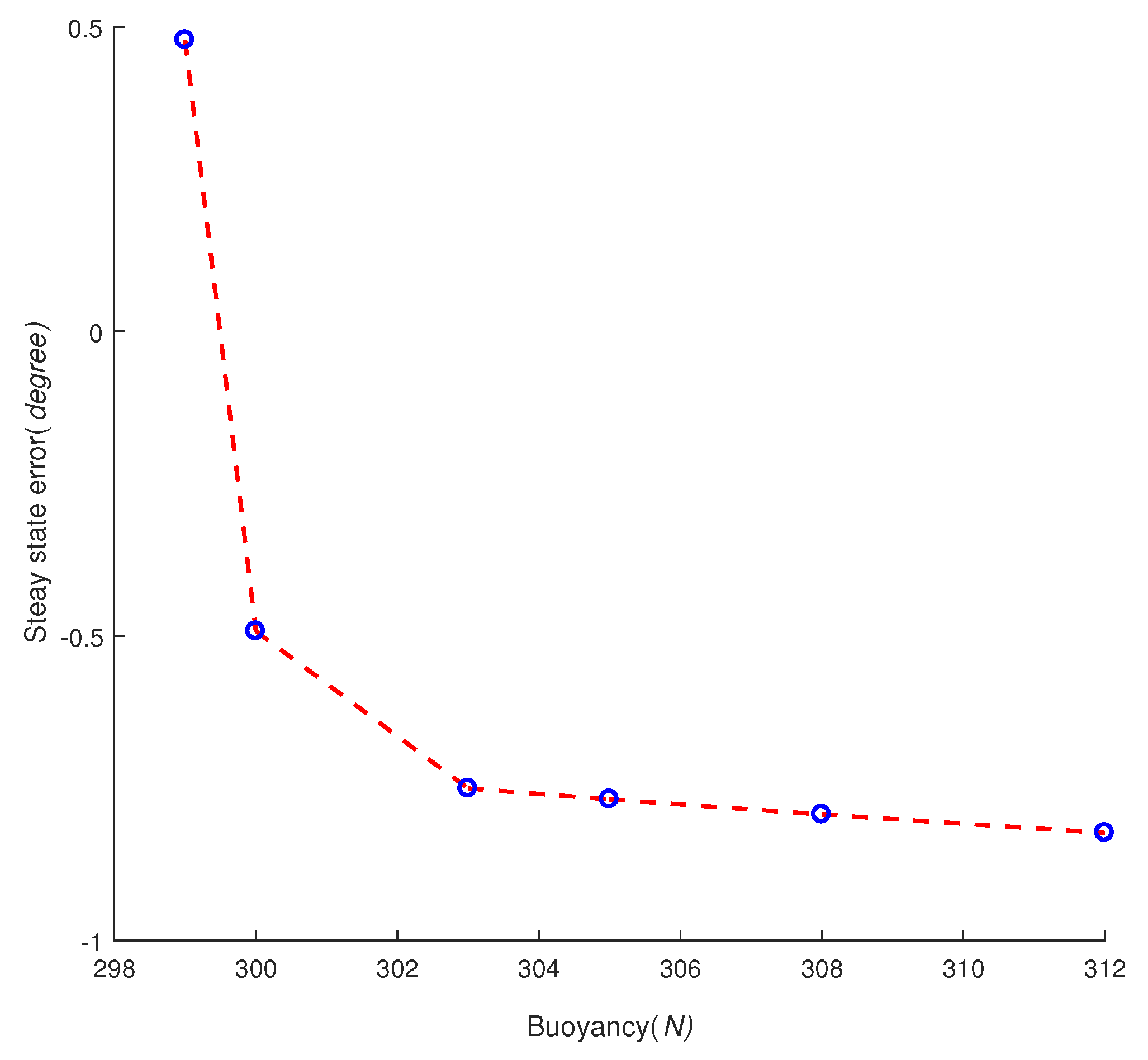

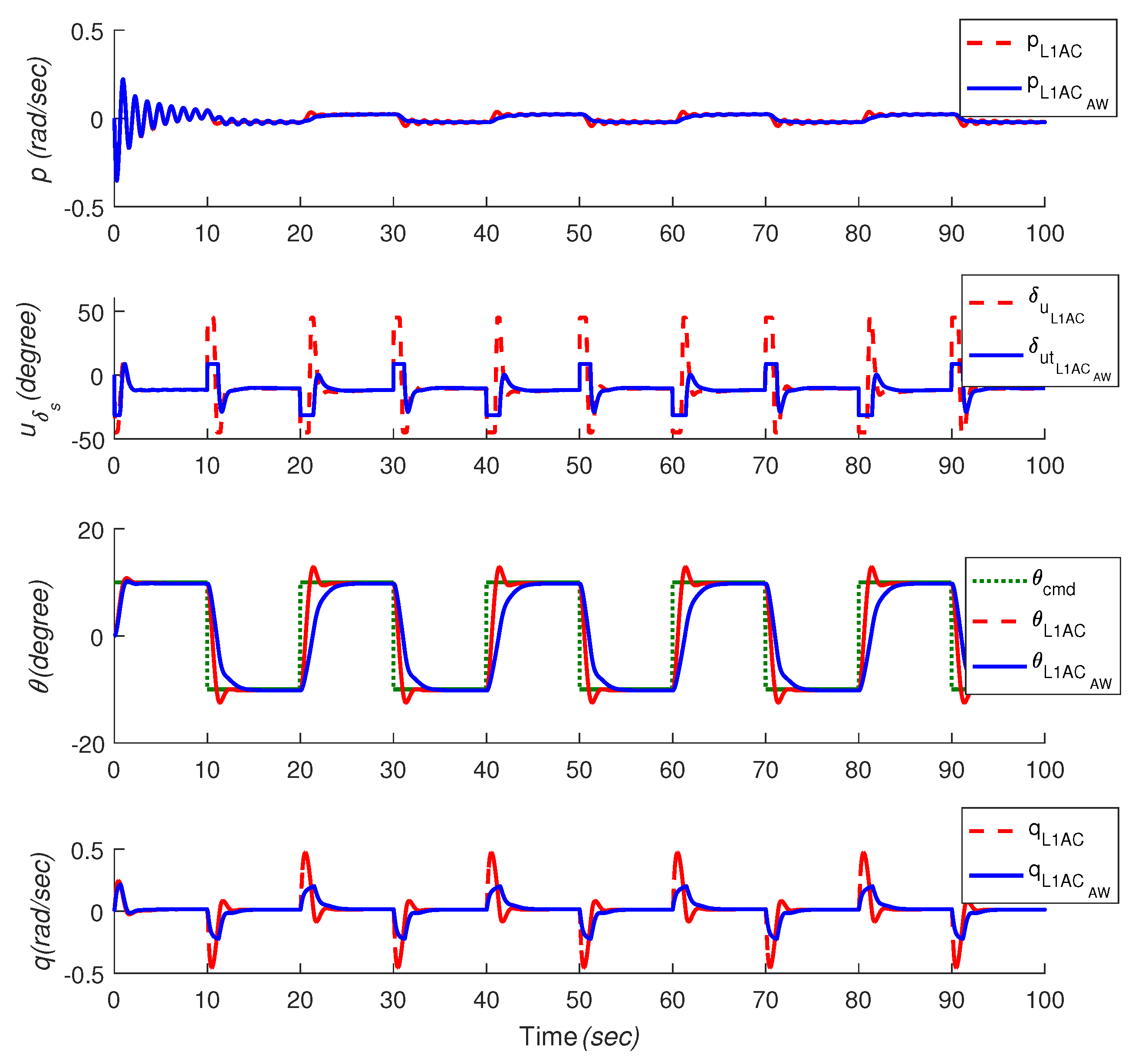

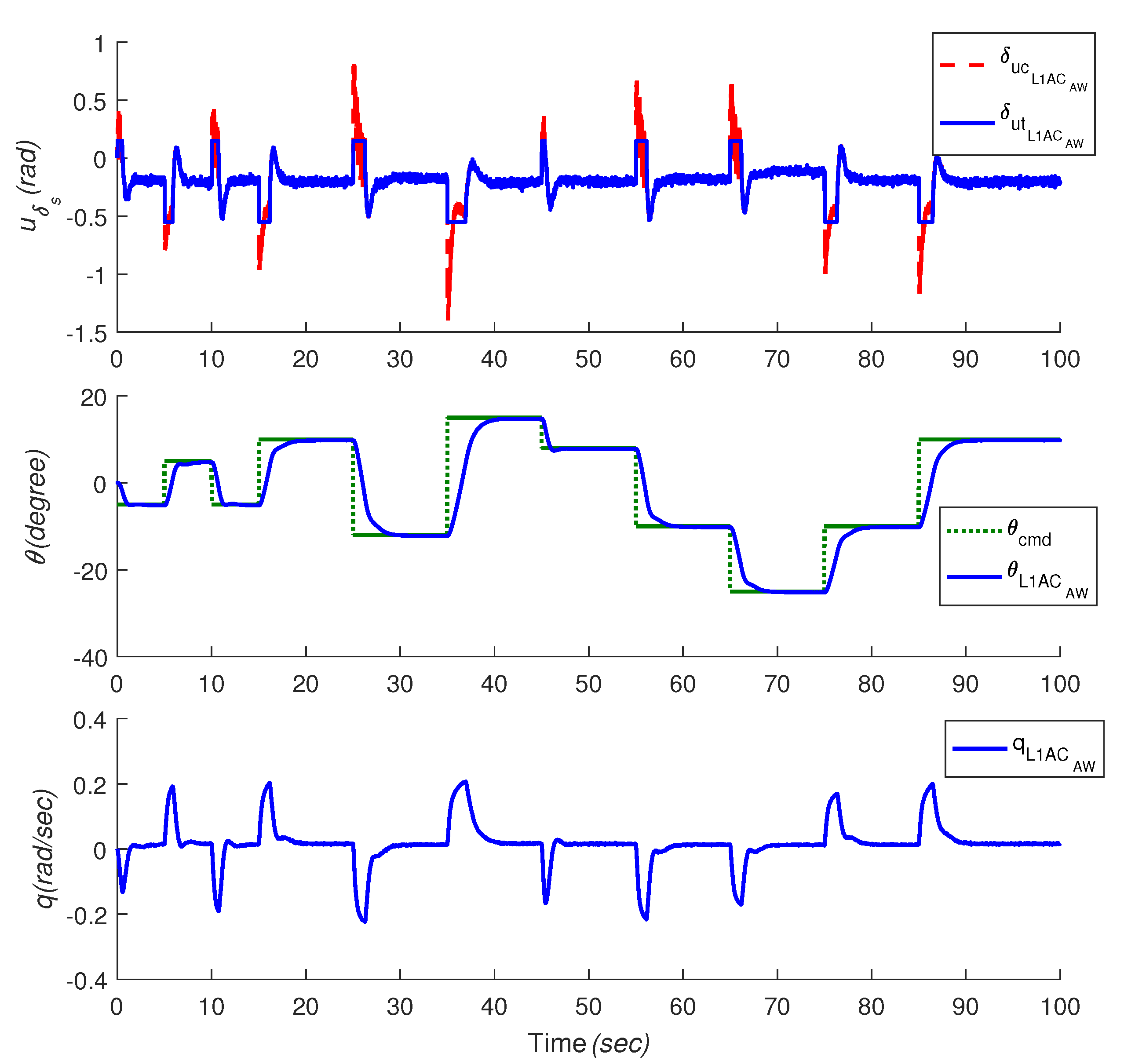
| Coordinate | Position & Angles E-Frame | Linear & Angular Velocities B-Frame | Forces & Moments B-Frame |
|---|---|---|---|
| Surge | X | u | |
| Sway | Y | v | |
| Heave | Z | w | |
| Roll | p | ||
| Pitch | q | ||
| Yaw | r |
© 2018 by the authors. Licensee MDPI, Basel, Switzerland. This article is an open access article distributed under the terms and conditions of the Creative Commons Attribution (CC BY) license (http://creativecommons.org/licenses/by/4.0/).
Share and Cite
Wu, N.; Wu, C.; Ge, T.; Yang, D.; Yang, R. Pitch Channel Control of a REMUS AUV with Input Saturation and Coupling Disturbances. Appl. Sci. 2018, 8, 253. https://doi.org/10.3390/app8020253
Wu N, Wu C, Ge T, Yang D, Yang R. Pitch Channel Control of a REMUS AUV with Input Saturation and Coupling Disturbances. Applied Sciences. 2018; 8(2):253. https://doi.org/10.3390/app8020253
Chicago/Turabian StyleWu, Nailong, Chao Wu, Tong Ge, Deqing Yang, and Rui Yang. 2018. "Pitch Channel Control of a REMUS AUV with Input Saturation and Coupling Disturbances" Applied Sciences 8, no. 2: 253. https://doi.org/10.3390/app8020253




